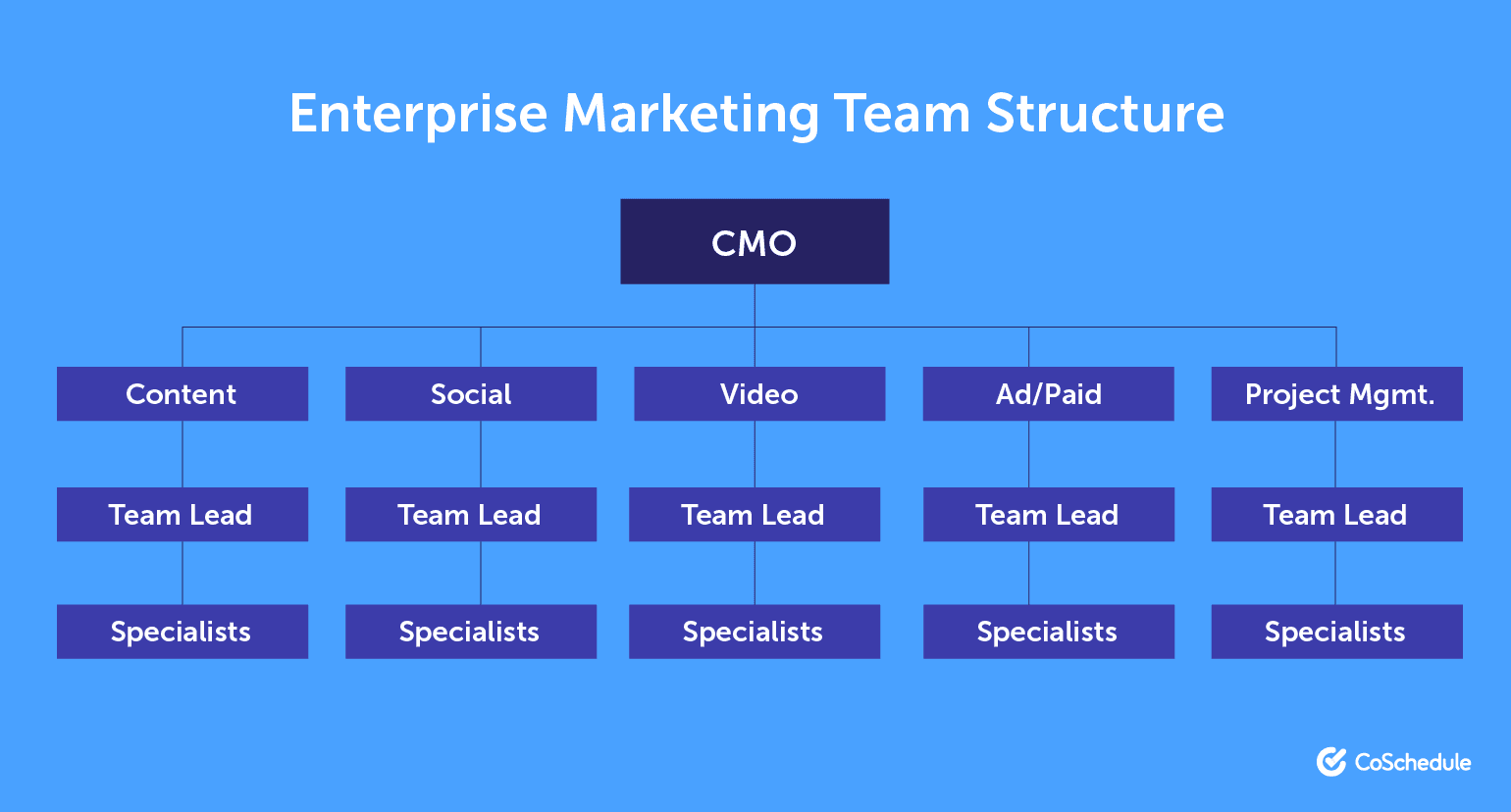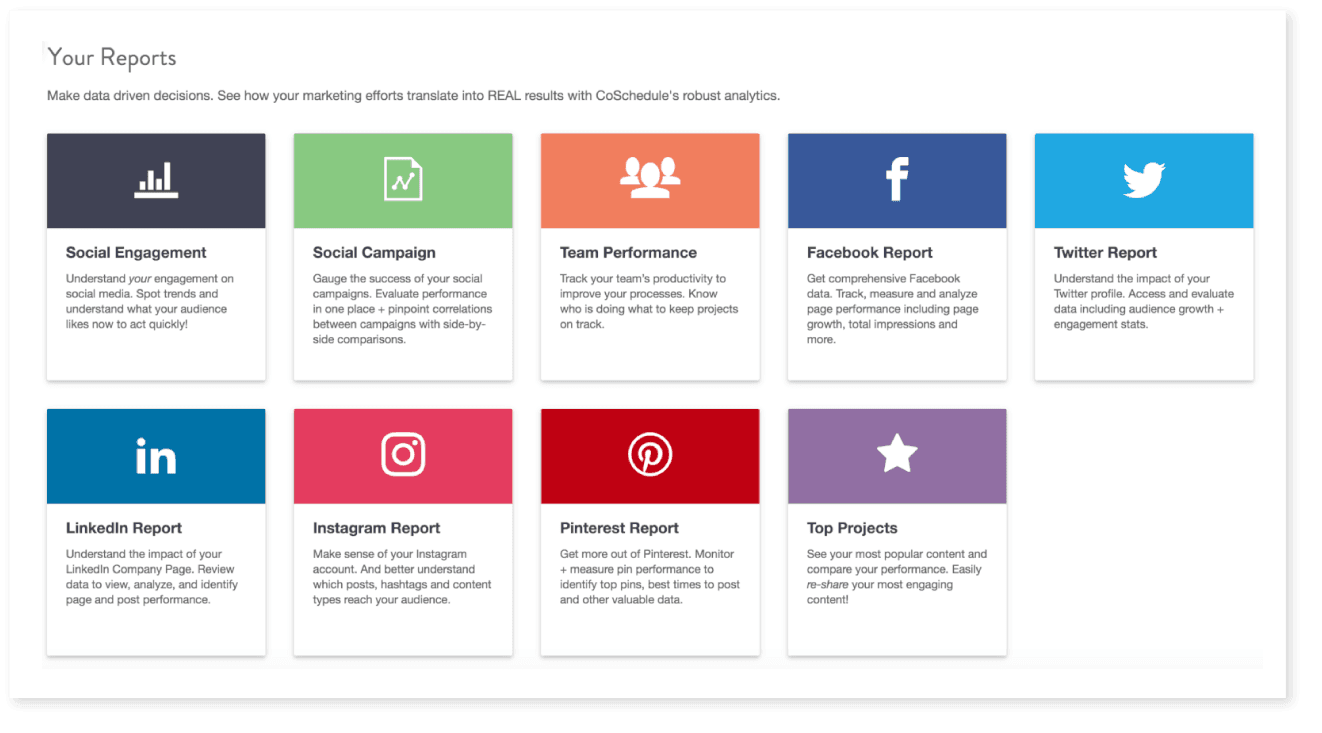How to Build and Organize the Best Marketing Team
 What does it take to build a modern marketing team?
That’s a question every company should be asking itself right now.
Even if you already have a fully-stocked marketing department.
Why?
Marketing hiring is set to increase by 10% overall by 2026 in the United States (the average growth rate across industries is 7%).
What does it take to build a modern marketing team?
That’s a question every company should be asking itself right now.
Even if you already have a fully-stocked marketing department.
Why?
Marketing hiring is set to increase by 10% overall by 2026 in the United States (the average growth rate across industries is 7%).
Get Your Free Marketing Org Chart Template
As you build your team, visualizing each role is important. With a clear org chart, everyone in the organization can know exactly where each team member fits, and how they impact the rest of the department. Grab this free template to map yours out easily.Introducing the Team Management Dashboard in CoSchedule: Effectively Manage Your Marketing Team
Once your marketing team is up and running, ensuring its success is key. However, keeping teams organized isn’t easy. That’s the problem our Team Management Dashboard in CoSchedule solves. Even if you don’t have a dedicated project manager on your team (and even if you do), it makes managing multiple team members (and all their projects and tasks) easy to do in one place. Here’s a look at how it works: Ready to try it yourself? Schedule a demo below:
What is the Role of a Modern Marketing Team?
You may expect a complex answer to this question. However, the real purpose of marketing can be boiled down into one simple statement: Marketing exists to drive profitable customer action. Sure, there are other broader business goals that marketing serves. Telling your story. Promoting your products. Converting customers into advocates (who tell your story and promote your products). But, in the end, building business and raising revenue is the ultimate purpose of marketing.Is your marketing team organized for success? Here's how to build a successful team.
Click To TweetWhich Positions Does a Marketing Team Need to Drive Profitable Action?
The needs of your team will depend on:- Your industry.
- Your company side.
- VP of Marketing
- Team Leads
- Writers
- Designers
- Analysts
- Project Managers
- Content Strategists
- Specialists (SEO, Email, Social, Etc.)
- PR
- Digital Marketing
- Writers. Content and copy are essential for practically every area of marketing. Competency with search engine optimization, email, content strategy, and social media marketing are all pluses as well.
- Designers. If your content and marketing collateral don’t look good, then everything else about it is bad, too.
- Analysts. Writers should know how to analyze data. Eventually, this may need to become a dedicated position.
- Project managers. Basic project management skills are useful for all marketers. Once your team reaches a mature level, adding this as a dedicated role may also be advisable.

Needs for Advanced Marketing Teams
What do marketing teams need when they mature past basic responsibilities and disciplines? Here are some areas to consider (including areas where the team at CoSchedule added and expanded after starting with just one marketer in 2013):- Automation specialists. The ability to use platforms like Salesforce and Autopilot effectively is crucial.
- Demand generation. Beyond just doing content marketing, building demand for your product, or even product category as a whole, is powerful.
- Marketing operations. This area is becoming a hot buzz term for managing technology, data, and resources. At a high level, it’s a mix of project management and resource allocation.
What Resources Do Marketing Teams Need to Succeed?
Bureaucratic red tape, budget constraints, and insufficient tools are three common culprits behind why marketing teams struggle (or even outright fail). So, how do you avoid these traps?Give Teams Creative and Strategic Latitude
Sometimes, it’s tough for the C-suite to let go of control over marketing. But, marketers get hired for a reason: they know what they’re doing. Companies should show that they understand this by letting marketers set the direction for their own teams. After all, you probably wouldn’t hire a firefighter to fix your drain, or a landscaper to work on your car. Let marketers do marketing, and let everyone else do what they do best, too.Permission to Forget 10% Projects
It’s easy to get bogged down in projects that make a marginal impact. It’s also hard to make meaningful progress that way. Spending too much time focusing on low-value activities can often leave teams feeling overly busy and yet unproductive. That’s a toxic combination. Not only does that mean they aren’t delivering everything they could be, no one worth their salt will want to remain in such an environment when they could get hired somewhere else. So, don’t force marketers to waste their time on things that aren’t important. Instead, focus on projects that deliver 10X results. This means activities that can improve a metric tenfold. Stack up enough such projects, and you’ll start to see much more substantial success in less time than before.
Don’t force marketers to waste their time on things that aren’t important.
Click To TweetGive Marketers the Right Tools
Companies often set up marketers with whatever tools and software other departments use. Sometimes, that’s okay. Other times, though, it’s a massive mistake. Marketers do a lot of specialized work that requires specific toolsets. They also have unique needs that generic communication and team management tools can’t adequately meet. What works for, say, software developers to manage tasks and projects, may not be ideal for marketers (even though they might grit their teeth and make it work). There’s also a heavy tendency toward using Excel for tasks that spreadsheets aren’t built to handle. What’s the solution? Invest in the right tools for the right jobs. Some essentials include:- Marketing management platform. CoSchedule solves the issue of “makeshift marketing” (the act of stitching together a martech stack out of disparate tools) by being a single hub where every project starts.
- Social media management software. There are tons of options out there. CoSchedule integrates with top social networks and WordPress, making it easy to publish and promote content in one place.
- Email marketing platforms. MailChimp, ActiveCampaign, Constant Contact, and Campaign Monitor integrate with CoSchedule.
- Analytics tools. Data-driven marketers need more than just Google Analytics to make effective decisions.
- Collaborative editing suite. G Suite (integrates with CoSchedule) and Microsoft Office 365 are both useful options.

Prioritizing Roles: Where Do You Even Start Building a Team?
This is no small task (which is why you’re here). But, you’ve to start building somewhere. When every role is important, how do you choose roles for your starting points? Here are two strategies to consider:- Starting with senior-level leadership. This person will know what kind of team they need. Finding someone looking to build from the ground up, in their own vision, could make this an enticing opportunity.
- Starting with a well-rounded generalist. Someone who can start executing effective work while figuring out what’s needed to take things to the next level.
What Might a Complete Marketing Team Look Like?
There’s no single way to structure a marketing team. And there isn’t really a specific point where a team might be considered “complete.” But, a small marketing team might look something like this: Which could grow into something more like this over time:
Which could grow into something more like this over time:

Where to Find the Talent You Need
A strong recruiting effort will leave no stone unturned to find the best talent possible to fit your team. Here are several places to consider starting your search.Networking Events
Professional meetup groups, conferences, speaking events, and other public industry events fall into this category. Look for places where your company might be able to set up a booth, or just show up and talk to people. You never know who you might meet.Social Media
Used strategically, social media can help you track down talented people looking for their next opportunity.- LinkedIn.
- Twitter.
- Facebook.
Hi, I’m [NAME], and I’m the [ROLE] at [COMPANY]. We’re looking to grow our marketing department, and I’m curious if you’re interested in opening up a conversation about what we have to offer? Let me know, it’d be great to grab a coffee when you have an opportunity. Thanks for your time.Feel free to edit this template. What’s most important is to offer a warm introduction and keep the focus on what you can do for the potential prospect’s career.
Career Directories
There are several sites where you can post job listings. Some popular ones include:- Indeed.
- Monster.
- CareerBuilder.
- Glassdoor.
- Craigslist.
- Local job boards.
- Newspaper ads.
Internship Programs
Successful interns can often make successful full-time employees. Have your interns shadow full-time staff, let them get some useful experience, and see if they have what it takes to deliver.Within Your Own Company
You might be able to find great fits for marketing roles from other departments in your own company. Now, you don’t want to poach staff or cause tension between your team and others. But, there might be someone in a role where they don’t feel like they’re the best fit. Or, they might have some previous or otherwise relevant experience that would make marketing an ideal area for them to be in.Career Fairs
You’ll have competition here, but you’ll also have face time with lots of potential candidates. There’s some investment involved in setting up a booth (printing collateral, developing talking points, and so forth) but the results can be worth the effort, particularly for finding intrepid interns and entry-level talent.Word of Mouth
Sometimes the best opportunities come from people you know, who know other people. Take a colleague at another company out for coffee. Hit up an old mentor you haven’t heard from in a while. Just put yourself out there and talk to people. You might be surprised where those conversations lead.Recruiting Previous Co-Workers
Some of the best hires you can make might currently be working at your (or your coworkers) former employers. If you like where you’re at (and you know your former coworkers, well, don’t enjoy their current positions so much), then they should be some of the first people you reach out to (so long as you’re not running the risk of burning bridges by poaching people).How To Structure Internal And External Marketing Teams (From CoSchedule CEO Garrett Moon)
In order to build the world's best all-in-one marketing management platform, CoSchedule needs to understand how modern blogging teams work. So, the team called, emailed, and Googled its way to understanding. The results are valuable. Marketing teams are diverse, but CoSchedule's research concluded that there are really only two major types of team structures, and then two minor ones that branch off from there. Understanding the strengths and weaknesses of these teams makes a huge difference in how you manage and organize your own writing team.Understanding a team makes a huge difference in how to manage & organize writing. #contentmarketing
Click To TweetThe Internal Team
The most familiar type of team is the internal team. Internal teams are usually defined by an internal self-contained team that handles marketing processes from top to bottom. There are usually several roles, including an editor (or two) and writers. Workflow:
Workflow:
- Idea Generation / Brainstorming (team meeting)
- Assignments
- Writing
- Editor Review (may lead back to step 3)
- Approval
- Publishing / Scheduling
- Internal communication is important. Often these teams rely heavily on email, or they employ a wide variety of random tools to "make it happen."
- These teams are very process-driven and can have difficulty adapting to new methods. Once it works, it works!
- Writers are often not writers at all, but rather professionals with the right topical knowledge for the job. This may require extra love and care from the editors.
- They need tools that can adapt to their unique workflow and tend to resist processes enforced by others.
The External Team
The external team is primarily composed of an internal editing staff with many external writers. Unlike the internal team where everything is handled in-house, the external team can be spread out. These teams are usually a "for-profit" venture, meaning they work to make money with their blog rather than simply promote an idea or concept. Typical Workflow:
Typical Workflow:
- External Ideas / Pitch
- Internal Approval of Planning / Pitch
- External Write / Submission
- Internal Review / Approval
- Internal Edit / Write
- Publish / Schedule
- Communication is always at the top of the list for external teams. They are often spread out, and rarely working at the same time of day. This makes a central point of communication a necessity.
- External teams often have a wide variety of roles and unique permissions needs. They work to accommodate each external contributor in unique ways.
- Often they have a fast-paced workflow and tend to move quickly. Today matters most.
- Editors of external blogs are usually a bit more flexible when it comes to workflow. Because there are more variables, they tend to "roll with the punches" better than others.
- External blogs are run like a business, and usually quite focused on traffic and revenue.
- They have heavy social media needs. This is an important aspect of their business
The Agency Team
An agency team falls somewhere in-between the internal and external team. It usually contains a small group of internal and editors but adds the external component of client review and editing. Often, clients behave in a somewhat "executive editor" role. Typical Workflow:
Typical Workflow:
- Idea Generation (with client interaction)
- Tasks (internal)
- Execution
- Editor Review / Approval
- Client Review / Approval
- Publish / Schedule
- There is a combined internal and external workflow with the addition of final client approval.
- Writing efforts are combined with additional client work, so the process may vary.
- Strategic planning and mapping is the key to this group. They tend to be more strategy-focused that other teams.
- The addition of clients will add many unique needs. Processes may vary!
The Solo Team
Not to be forgotten is the "solo" blogging team, usually comprised of one or two people with a less structured process. This team offers the greatest variety and the greatest volatility. Many solo bloggers are in it for fun, but may blog for self-promotional purposes, or even some profit. Typical Workflow:
Typical Workflow:
- Idea
- Execution
- Publish
- Speed and efficiency are very important to this group. They need to get in and get out.
- Scheduling needs are fairly basic. They tend to use that calendar as a way to motivate themselves to write.
So, Where Do You Fit?
So, what kind of team are you? Is our description accurate? Maybe you have never really thought about what kind of team you are, but it is actually quite important. Once we understood some of the unique needs that our team had, we were able to diagnose and fix the problems. This makes for better teams, and better blogs, in the long run.Adding Your Team to CoSchedule
CoSchedule is a marketing management platform that’s purpose-built for collaborative teams. Start by inviting each team member to your company’s CoSchedule calendar: Now, you’ll be able to assign team members to projects, and add tasks to team members within those projects:
Now, you’ll be able to assign team members to projects, and add tasks to team members within those projects:
 Those projects are all easy to view on one calendar too, giving everyone on the team full visibility into what is being worked on, and who is doing what, and when:
Those projects are all easy to view on one calendar too, giving everyone on the team full visibility into what is being worked on, and who is doing what, and when:

Managing Marketers With the Team Management Dashboard
Now is a good time to call attention to the Team Management Dashboard one more time, too. It makes it simple to get a closer look into each individual team member’s workloads. Here’s a second look at how it works:Measuring Productivity With Team Performance Reports
Keeping organized serves the goal of keeping productive. Team Performance Reports help prove your marketers are getting it done. Click into the Analytics tab: Then, find Team Performance Reports:
Then, find Team Performance Reports:
 Now, you can see exactly what percentage of tasks each team member is completing on time:
Now, you can see exactly what percentage of tasks each team member is completing on time:

Additional Reading
Looking for more resources on building and managing teams? Here are some quick links to more posts you might find useful:How Will You Build Your Team?
Big things start small. Even effective marketing departments. Equipped with the right knowledge and a scalable process for starting from one hire, and building all the way up to a full-fledged multi-team department though, you’ll be able to mature your marketing alongside your business.


